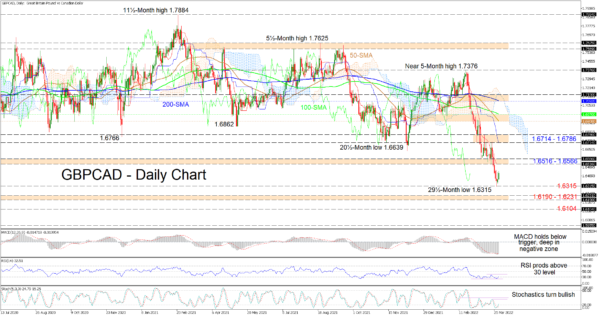GBPCAD is improving from the 29½-month low of 1.6315 but the near six-week decline from 1.7376 high remains intact below the 1.6714-1.6786 resistance boundary. The falling simple moving averages (SMAs) continue to endorse a deteriorating outlook in the pair.
Moreover, the diving Ichimoku lines indicate that prevailing bearish forces are present, while the short-term oscillators are reflecting the renewed pickup in positive momentum. The MACD, far below the zero threshold, is just beneath its flattened red trigger line, while the RSI has nudged back above the 20 level. Furthermore, the stochastic %K line has pushed north of the 20 oversold level, promoting additional bullish price action in the pair.
In the positive scenario, upside constraints could commence from the 1.6516-1.6566 resistance band that extends back to March 2020. If bullish forces intensify, the pair may then jump to tackle the 1.6714-1.6786 resistance barrier where the blue Kijun-sen line also resides. In the event buyer’s positive traction endures for longer, they could then challenge the section of resistance between the 50-day SMA at 1.6908 and the 100-day SMA at 1.6970.
Alternatively, if negative pressures start to overwhelm again, initial support could arise from the two-and-a-half-year trough of 1.6315. However, should the descent resume, the 1.6190-1.6231 support border shaped by the lows in the first part of October 2019 may contest sellers’ efforts to fortify the bearish trajectory. If the 1.6190-1.6231 critical defence fails to dismiss the decline, the spotlight could then turn to the 1.6104 trough identified in September 2019.
Summarizing, GBPCAD continues to exhibit a bearish bias below the 1.6714-1.6786 boundary despite its recent improvements. A break below the 1.6190-1.6231 support could ramp up negative pressures, while a climb in the price beyond the 1.6714-1.6786 barrier may dampen the negative outlook to a degree.














